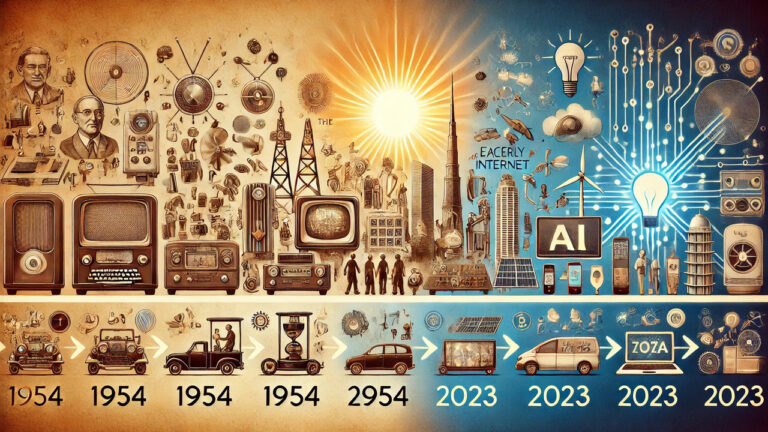Introduction to 2023-1954
2023-1954 encapsulates various technological advancements and historical milestones. It signifies a timeline of progression, innovation, and transformation. This article delves into the significance of these years, exploring the groundbreaking changes and developments that have shaped our world.
The Technological Landscape of 1954
Early Innovations and Milestones
The year 1954 marked a pivotal moment in the technological world. It was an era characterized by the dawn of modern electronics and the burgeoning field of computer science. Key innovations during this period included the development of the first transistor radios, which revolutionized communication by making it more portable and accessible.
The Birth of Nuclear Power
Another monumental achievement in 1954 was commissioning the world’s first nuclear power plant in Obninsk, Soviet Union. This event signified the beginning of a new era in energy production, showcasing nuclear power’s potential to provide a significant and reliable energy source.
Leap to 2023: Technological Transformation
The Rise of Artificial Intelligence
Fast forward to 2023, and the technological landscape has transformed beyond recognition. One of the most significant advancements is the rise of artificial intelligence (AI). AI technologies, such as ChatGPT, have revolutionized how we interact with machines, providing more natural and intuitive user experiences. These AI systems can understand and respond to human language, making them invaluable tools in various applications, from customer service to content creation.
Integration of AI in Daily Life
By 2023, AI has become deeply integrated into daily life. AI is ubiquitous, from smart home devices that control lighting and temperature to AI-driven personal assistants that manage schedules and tasks. These advancements have streamlined daily routines, increased productivity, and enhanced overall quality of life.
The Evolution of Communication: 1954 vs. 2023
Communication in 1954
In 1954, communication was primarily through landline telephones, letters, and radio broadcasts. The invention of the transistor radio made information more accessible, but the methods of communication were still relatively slow and limited in reach.
Modern Communication Technologies
The advent of the internet and mobile technology will revolutionize communication by 2023. Today, we have instant messaging, video calls, social media, and numerous other platforms that enable real-time, global communication. The development of 5G technology has further enhanced connectivity, providing faster and more reliable internet access, even in remote areas.
Healthcare Advances from 1954 to 2023
Medical Innovations in the 1950s
The 1950s saw significant progress in medical science, including the widespread use of antibiotics and Jonas Salk’s development of the polio vaccine. These advancements profoundly impacted public health, drastically reducing mortality rates from infectious diseases.
Modern Healthcare Technologies
By 2023, technology will transform healthcare. Telemedicine allows patients to consult with doctors remotely, while wearable health devices monitor vital signs in real-time. Additionally, biotechnology and genetic engineering advancements have paved the way for personalized medicine, where treatments are tailored to an individual’s genetic profile.
The Environmental Impact: Then and Now
Environmental Awareness in 1954
In 1954, environmental awareness was minimal. Industrialization was at its peak, focusing primarily on economic growth rather than environmental conservation. The consequences of pollution and resource depletion still need to be fully understood and addressed.
Environmental Technologies in 2023
In contrast, 2023 is marked by a heightened awareness of environmental issues. Technological innovations have provided new solutions for sustainable living. Renewable energy sources, such as solar and wind power, are now mainstream, reducing our reliance on fossil fuels. Furthermore, advancements in waste management and recycling technologies are helping to mitigate the impact of human activities on the environment.
The Role of Education in Technological Progress
Educational Trends in 1954
Education in 1954 was essentially traditional, focusing on rote learning and memorization. Access to higher education was limited, and educational resources were less widely available than they are today.
Modern Educational Technologies
By 2023, technology will transform education. Online learning platforms, virtual classrooms, and interactive digital resources have made education more accessible and engaging. AI-powered tools provide personalized learning experiences, helping students learn at their own pace and according to their individual needs.
Conclusion: Reflecting on “2023-1954“
The timeline from 1954 to 2023 showcases a remarkable journey of technological evolution. The progress made over these decades is astounding, from the early days of transistor radios and nuclear power to the modern era of AI and advanced communication technologies. This period highlights the relentless pursuit of innovation and the profound impact of technology on every aspect of our lives. The lessons learned from this timeline will undoubtedly guide future developments as we continue to advance, ensuring that technology continues to enhance and improve our world.
Also Read: Pondershort.com: The Complete Guide to Uncovering the Startling Secrets of the Website
